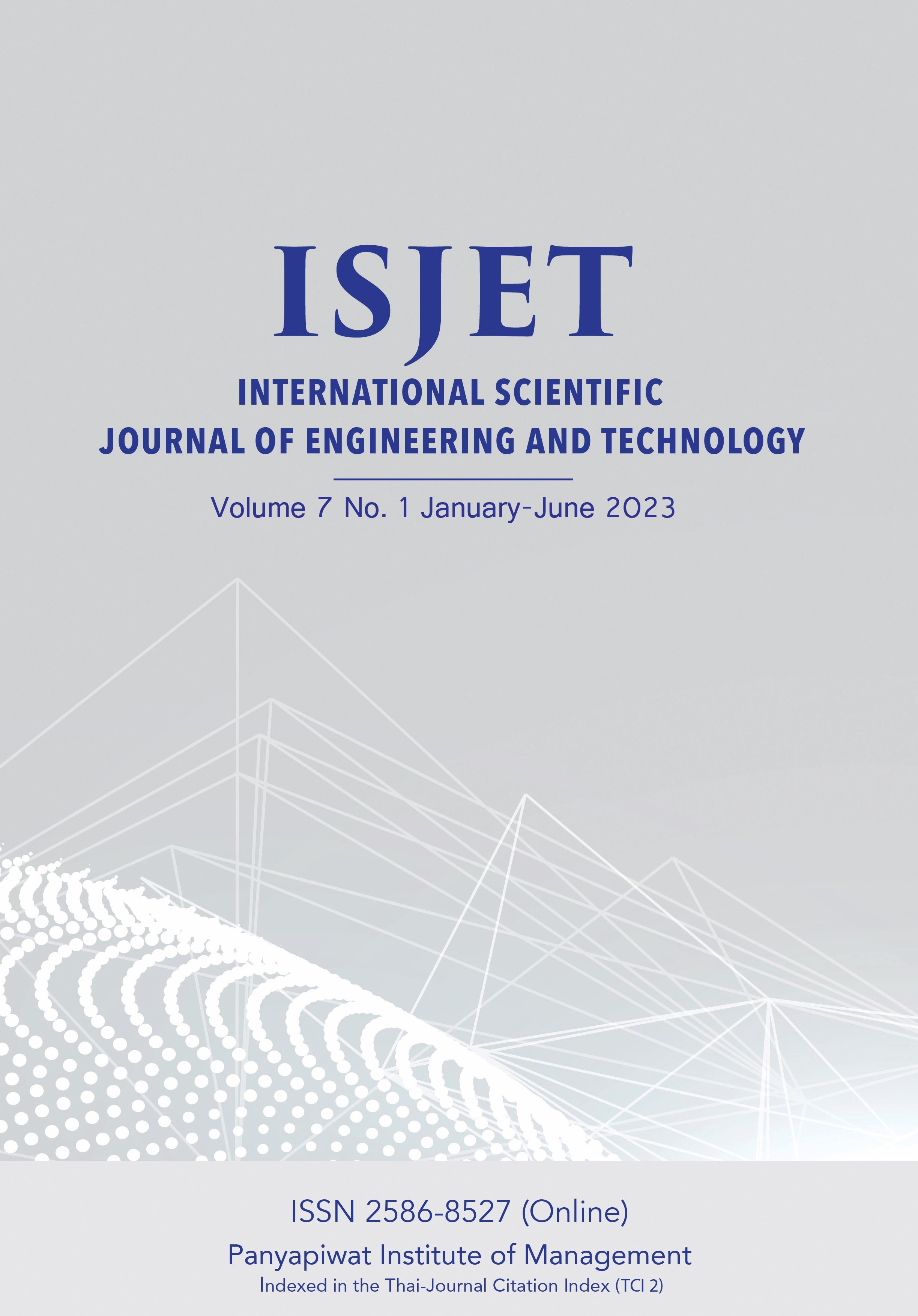Study of Effects of Inlet Wind Velocity and Direction on Airflow around the Buildings Using CFD Turbulence Models: A Case Study of Rajamangala University of Technology Rattanakosin (Salaya Campus), Thailand
Main Article Content
Abstract
This research investigates of the effects of inlet wind velocity and inlet wind direction on airflow around the buildings of Rajamangala
University of Technology Rattanakosin (Salaya), Thailand using Computational Fluid Dynamics (CFD) turbulence models. The evaluation of a CFD model’s performance and validation of its predictions with high-quality experimental data is necessary before the model is used in practice. In this study, there are 2 Models. Model 1 is the simulation for an inlet wind velocity of 0.5 and 1.5 m/s in the west direction. Model 2 is the simulation for an inlet wind velocity of 0.5 and 1.5 m/s in the south direction. The results were found that the
higher inlet wind speeds at the inlet flow boundary would lead to a higher increase in the average speed of air around the building. In addition, the combined wind speed and inlet flow direction were affected to where the maximum wind speed occurs. The data obtained from this study will serve as a future basis for the construction of buildings in the university to provide better natural ventilation.
Article Details

This work is licensed under a Creative Commons Attribution-NonCommercial-NoDerivatives 4.0 International License.
เนื้อหาข้อมูล
References
E. Trepci, P. Maghelal, and E. Azar, “Urban Built Context as a Passive Cooling Strategy for Buildings in a Hot Climate,” Energy and Buildings, vol. 231, p. 110606, Jan. 2021.
N. Ba Chien, N. Viet Dung, T. Quoc Dung et al., “CFD Simulation of Multi-Outdoor Unit Configuration Design for a Building,” IOP Conference Series: Earth and Environmental Science, vol. 505, no. 1, p. 12007, Jul. 2020.
A. Izadi, M. Rudd, and V. M. Patrick, “The Way the Wind Blows: Direction of Airflow Energizes Consumers and Fuels Creative Engagement,” Journal of Retailing, vol. 95, pp. 143-157, Sep. 2019.
Q. Yi, M. Konig, D. Jank et al., “Wind Tunnel Investigations of Sidewall Opening Effects on Indoor Airflows of a Cross-Ventilated Dairy Building,” Energy and Buildings, vol. 175, pp. 163-172, Jul. 2018.
X. Zhang, A. U. Weerasuriya, and K. T. Tse, “CFD Simulation of Natural Ventilation of a Generic Building in Various Incident Wind Directions: Comparison of Turbulence Modeling, Evaluation Methods, and Ventilation Mechanisms,” Energy and Buildings, vol. 229, p. 110516, Dec. 2020.
G. K. Ntinas, X. Shen, Y. Wang et al., “Evaluation of CFD Turbulence Models for Simulating External Airflow Around Varied Building Roof with Wind Tunnel Experiment,” Building Simulation, vol. 11, no. 1, pp. 115-123, Apr. 2018.
W. Zuo and Q. Chen, “Real‐Time or Faster‐Than‐Real‐Time Simulation of Airflow in Buildings,” Indoor Air, vol. 19, no. 1, pp. 33-44, Feb. 2009.
F. Ascione, R. F. de Masi, M. Mastellone et al., “The Design of Safe Classrooms of Educational Buildings for Facing Contagions and Transmission of Diseases: A Novel Approach Combining Audits, Calibrated Energy Models, Building Performance (BPS) and Computational Fluid Dynamic (CFD) Simulations,” Energy and Buildings, vol. 230, p. 110533, Jan. 2021.
J. K. Calautit, D. O’Connor, P. W. Tien et al., “Development of a Natural Ventilation Windcatcher with Passive Heat Recovery Wheel for Mild-Cold Climates: CFD and Experimental Analysis,” Renewable Energy, vol. 160, pp. 465-482, Nov. 2020.
M. M. Hefny and R. Ooka, “Influence of Cell Geometry and Mesh Resolution on Large Eddy Simulation Predictions of Flow Around a Single Building,” Building Simulation, vol. 1, no. 3, pp. 251-260, Sep. 2008.
R. Ramponi and B. Blocken, “CFD Simulation of CrossVentilation for a Generic Isolated Building: Impact of Computational Parameters,” Building and Environment, vol. 53, pp. 34-48, Jul. 2012.
K. H. Cheong, Y. H. Teo, J. M. Koh et al., “A SimulationAided Approach in Improving Thermal-Visual Comfort and Power Efficiency in Buildings,” Journal of Building Engineering, vol. 27, p. 100936, Jan. 2020.
X. Tong, S. W. Hong, and L. Zhao, “CFD Modeling of Airflow, Thermal Environment, and Ammonia Concentration Distribution in a Commercial Manure-Belt Layer House with Mixed Ventilation Systems,” Computers and Electronics in Agriculture, vol. 162, pp. 281-299, Jul. 2019.
M. F. Yassin, “Numerical Study of Flow and Gas Diffusion in the Near-Wake Behind an Isolated Building,” Advances in Atmospheric Sciences, vol. 26, no. 6, pp. 1241-1252, Nov. 2009.
M. Ning, S. Mengjie, C. Mingyin et al., “Computational Fluid Dynamics (CFD) Modelling of Air Flow Field, Mean Age of Air and CO2 Distributions Inside a Bedroom with Different Heights of Conditioned Air Supply Outlet,” Applied Energy, vol. 164, pp. 906-915, Feb. 2016.
M. S. Al-Homoud, “Computer-Aided Building Energy Analysis Techniques,” Building and Environment, vol. 36, no. 4, pp. 421-433, May. 2001.
Q. Cheng, H. Li, L. Rong et al., “Using CFD to Assess the Influence of Ceiling Deflector Design on Airflow Distribution In the Hen House with Tunnel Ventilation,” Computers and Electronics in Agriculture, vol. 151, pp. 165-174, Aug. 2018.
C. Porras-Amores, F. R. Mazarrón, I. Cañas et al., “Natural Ventilation Analysis in an Underground Construction: CFD Simulation and Experimental Validation,” Tunnelling and Underground Space Technology, vol. 90, pp. 162-173, Aug. 2019.
B. E. Launder and D. B. Spalding, “The Numerical Computation of Turbulent Flows,” Computer Methods in Applied Mechanics and Engineering, vol. 3, no. 2, pp. 269-289, Mar. 1974.
S. J. G. Shoba and A. B. Therese, “Detection of Glaucoma Disease in Fundus Images Based on Morphological Operation and Finite Element Method,” Biomedical Signal Processing and Control, vol. 62, p. 101986, Sep. 2020.
N. Mao, M. Song, D. Pan et al., “Computational Fluid Dynamics Analysis of Convective Heat Transfer Coefficients for a Sleeping Human Body,” Applied Thermal Engineering, vol. 117, pp. 385-396, May. 2017.


